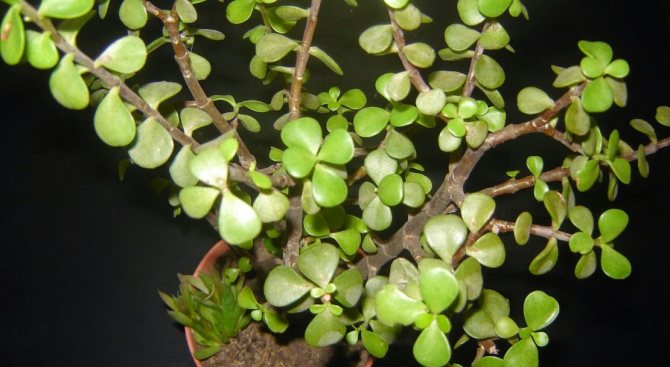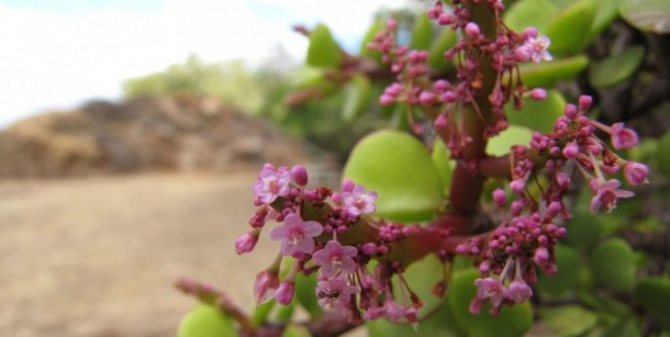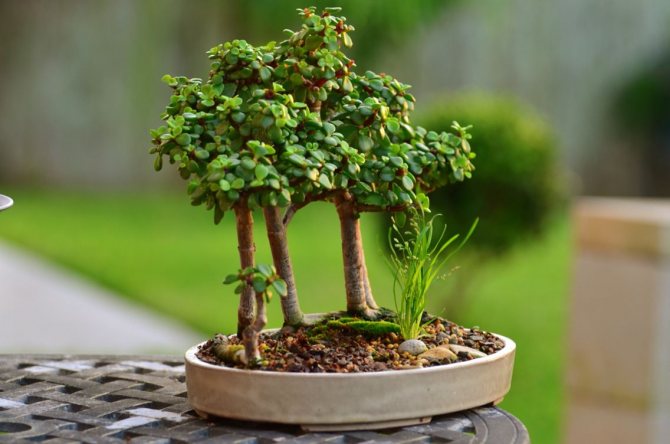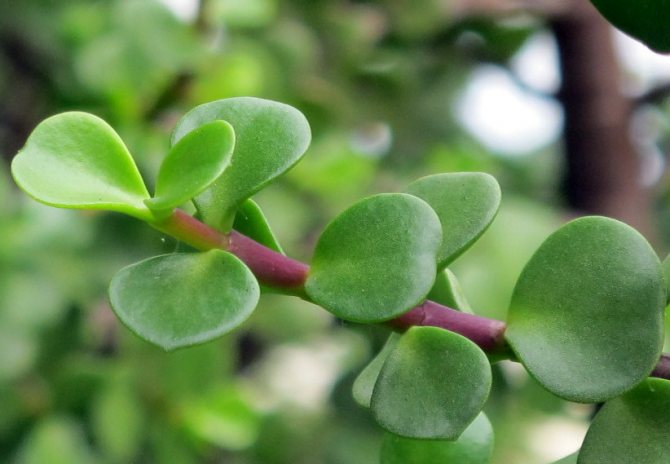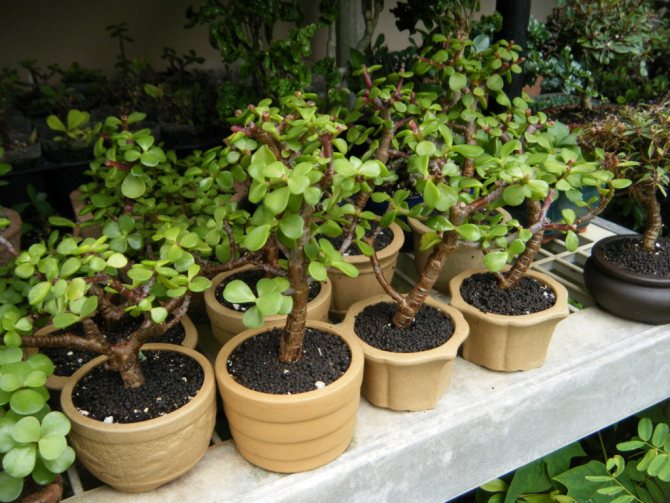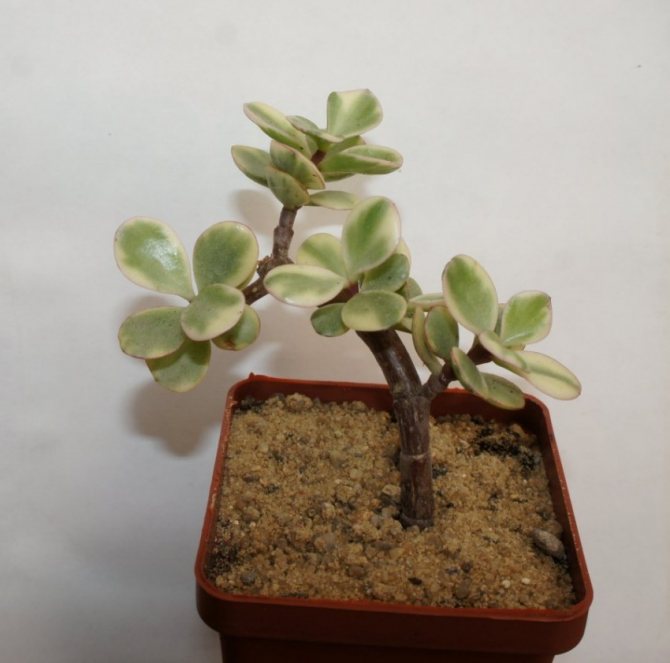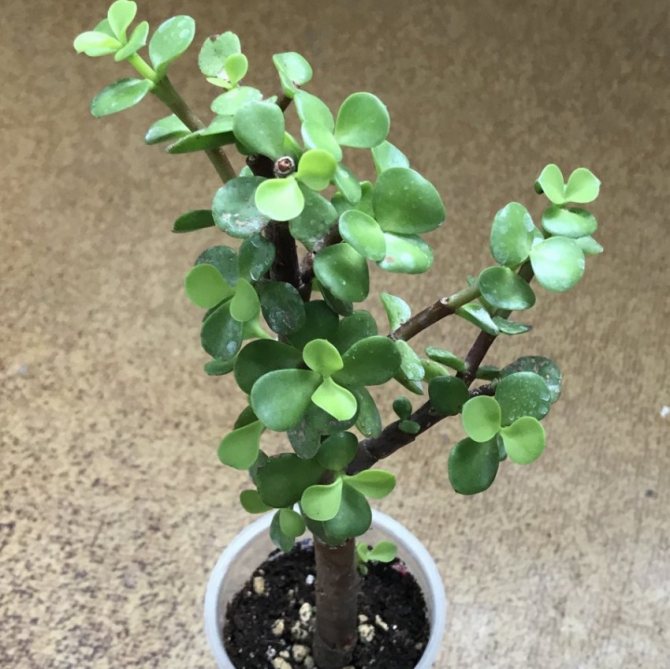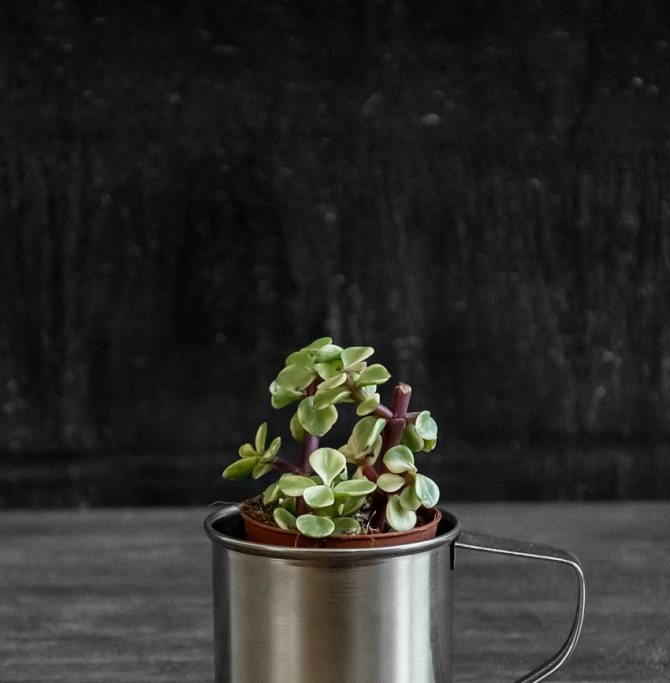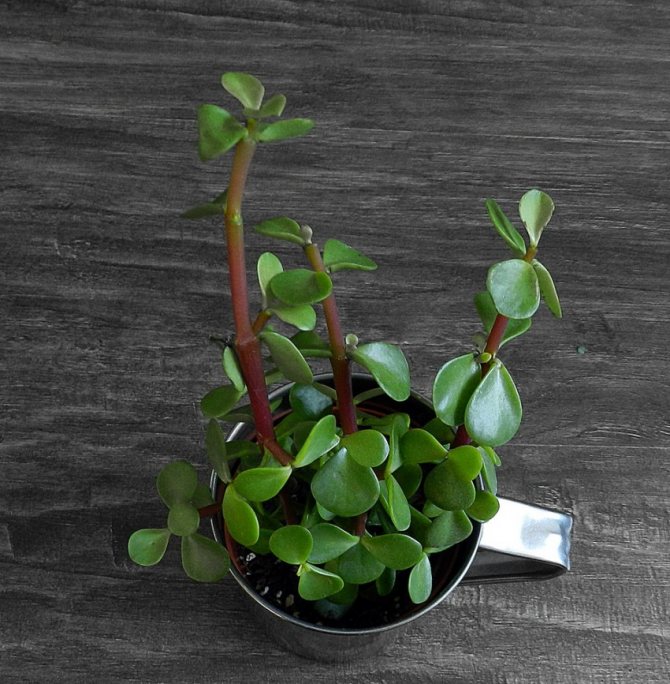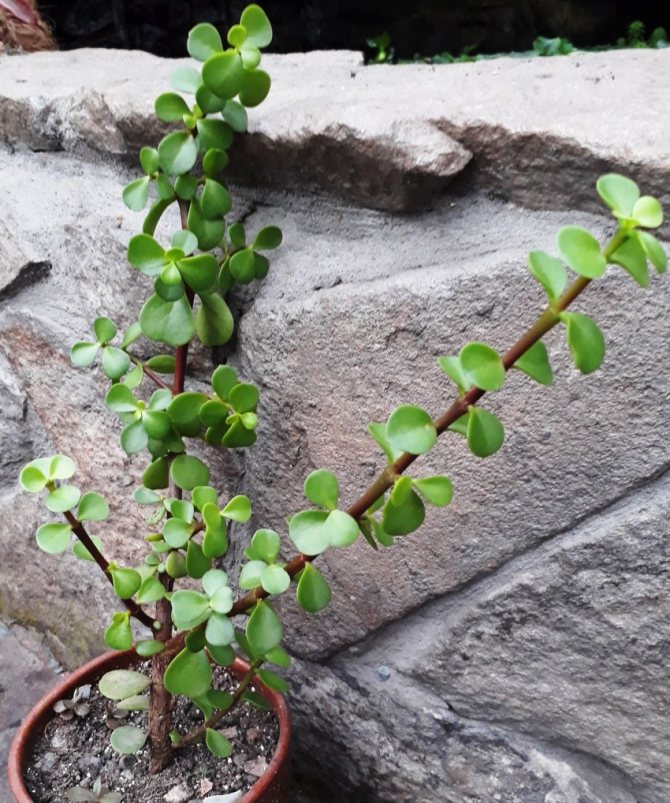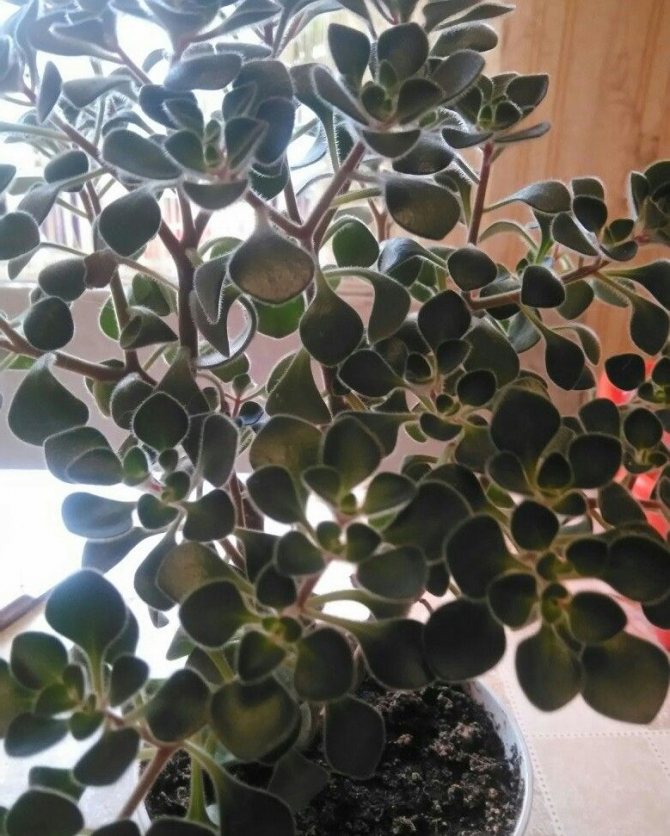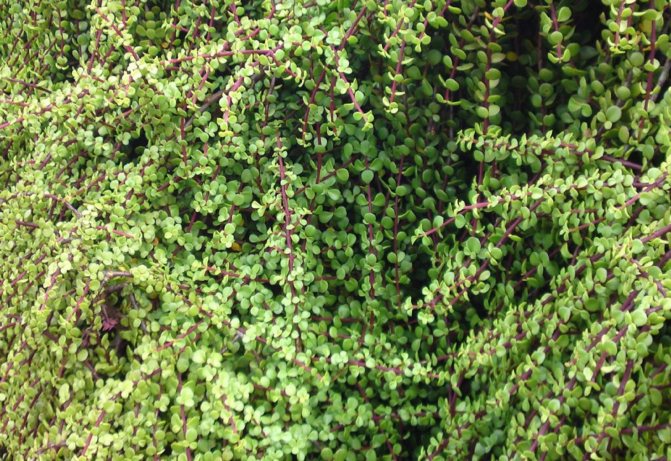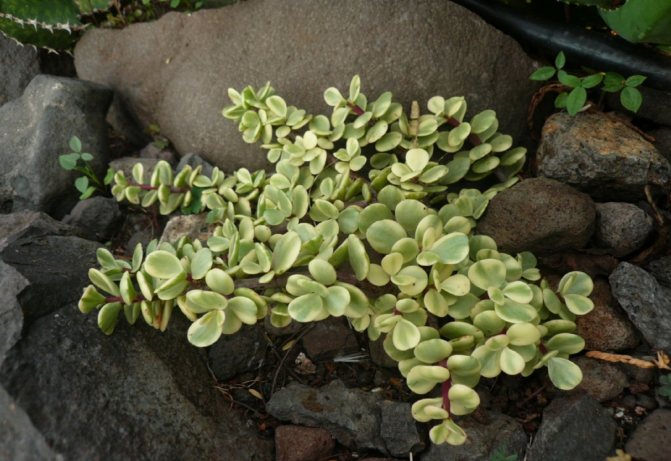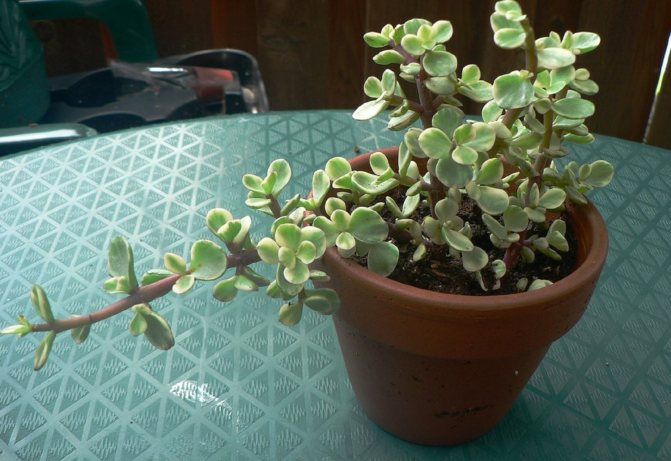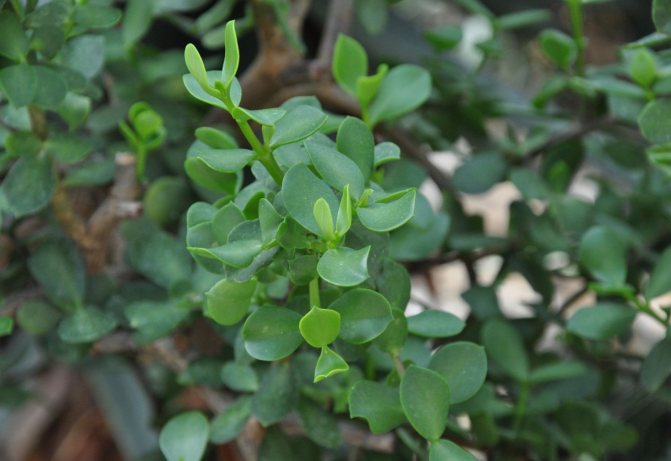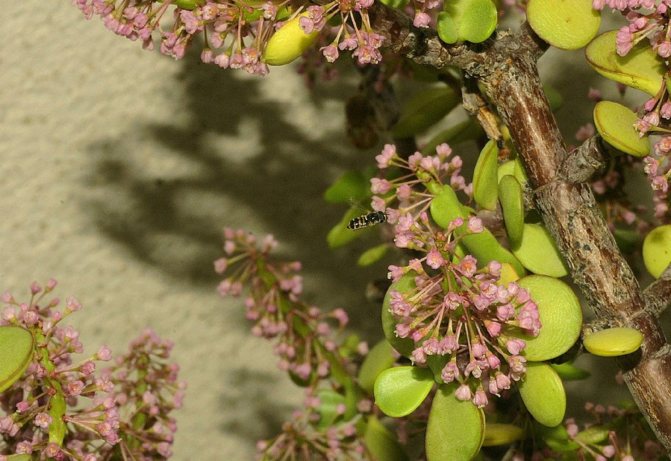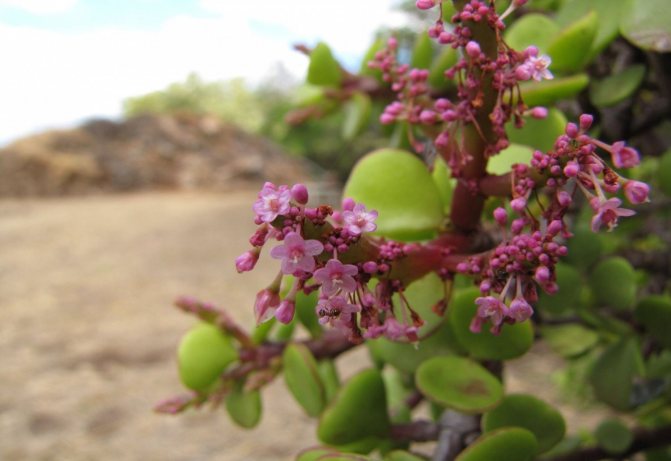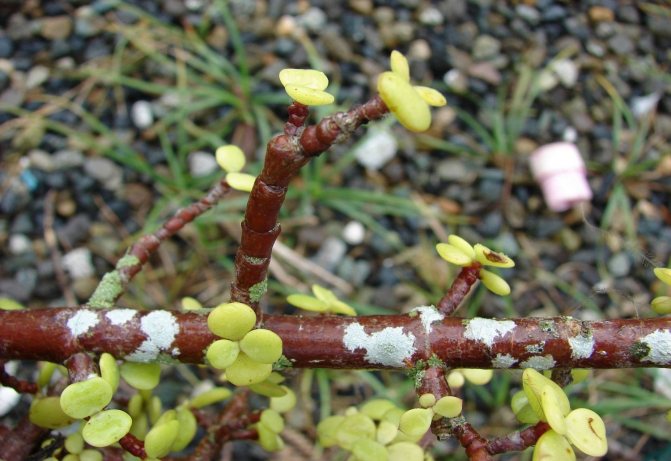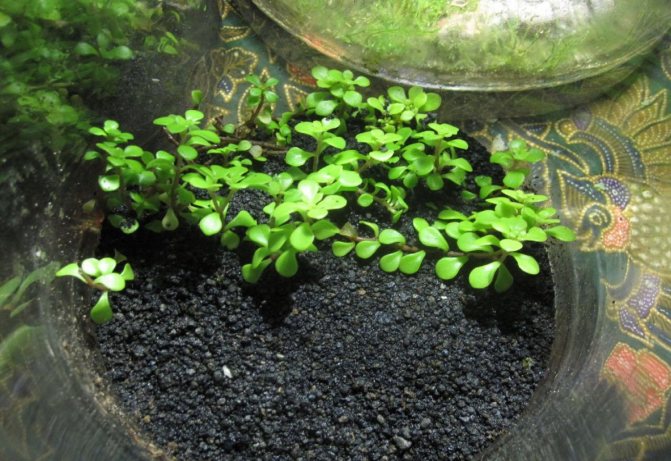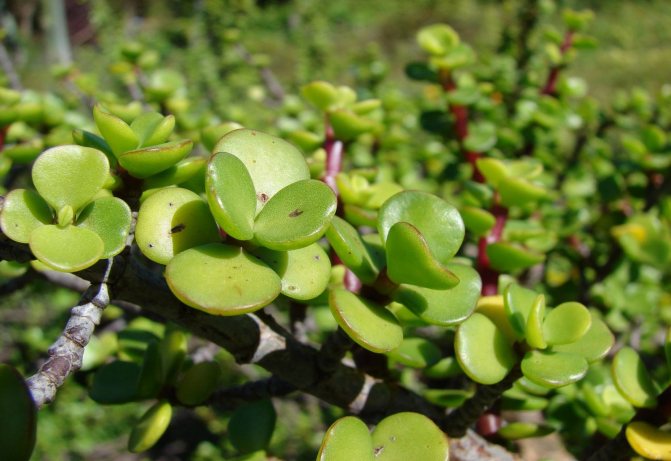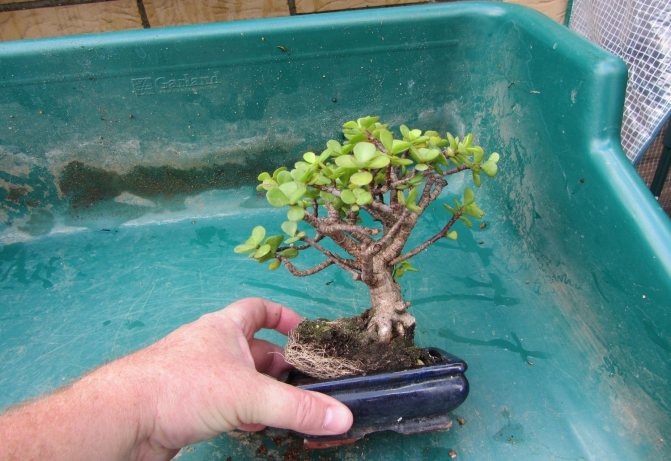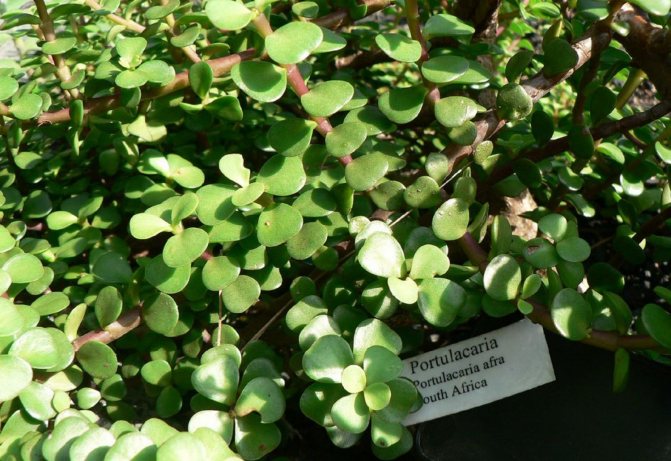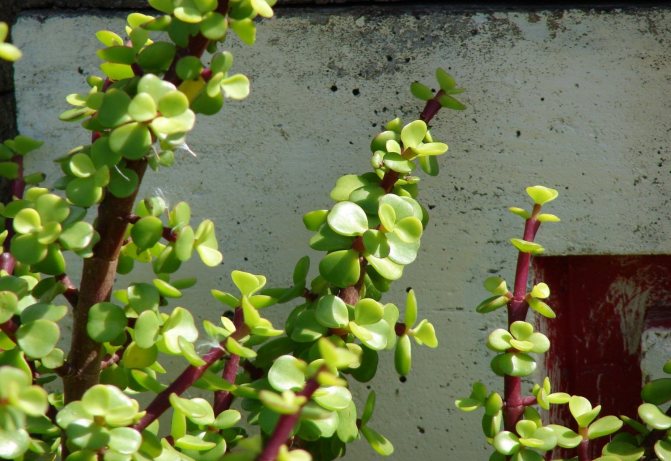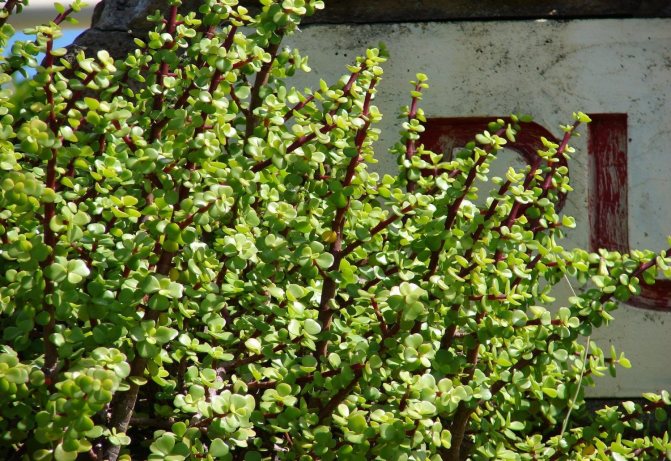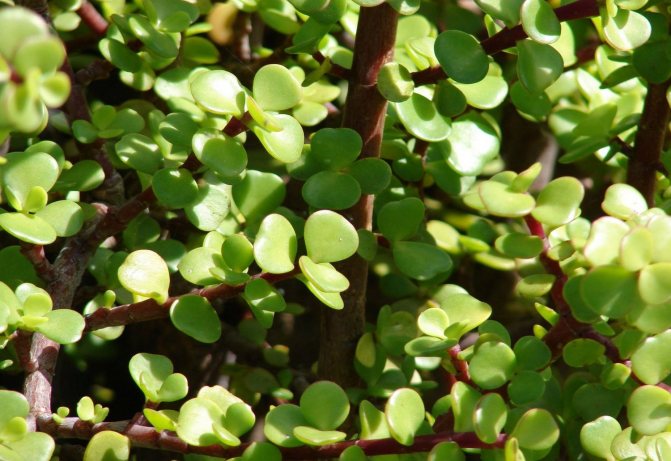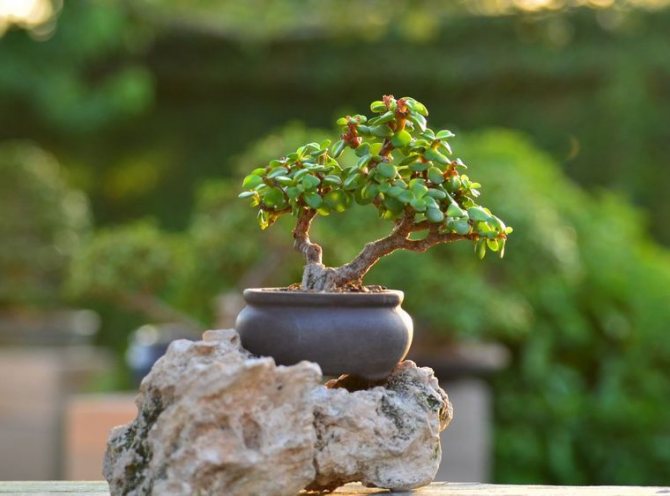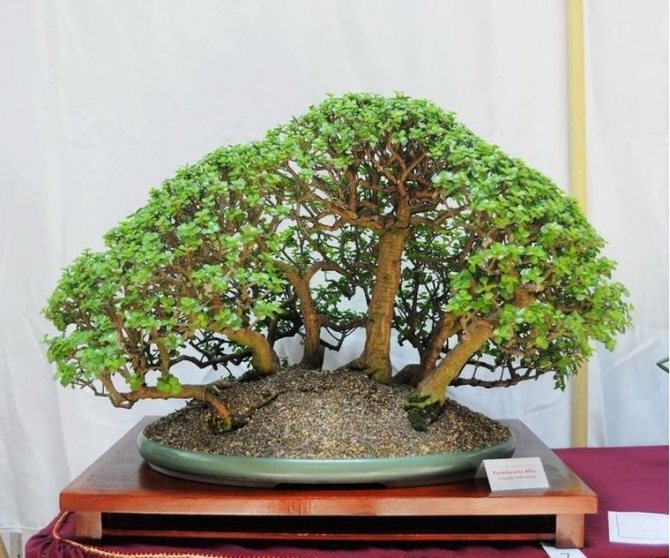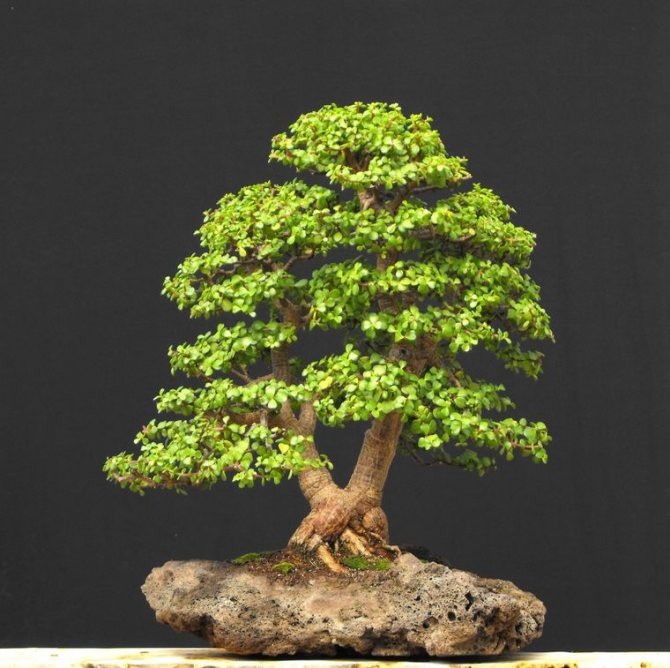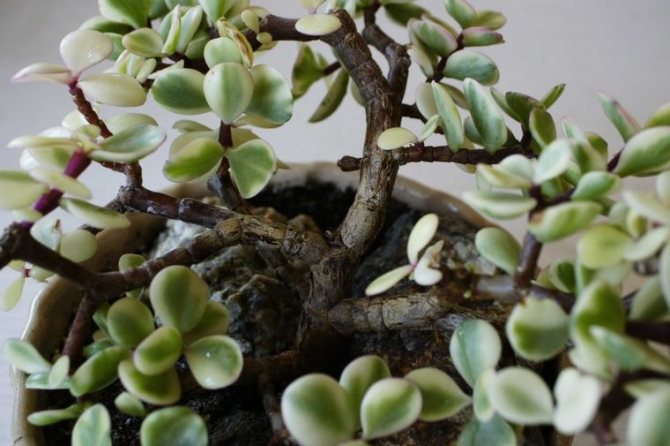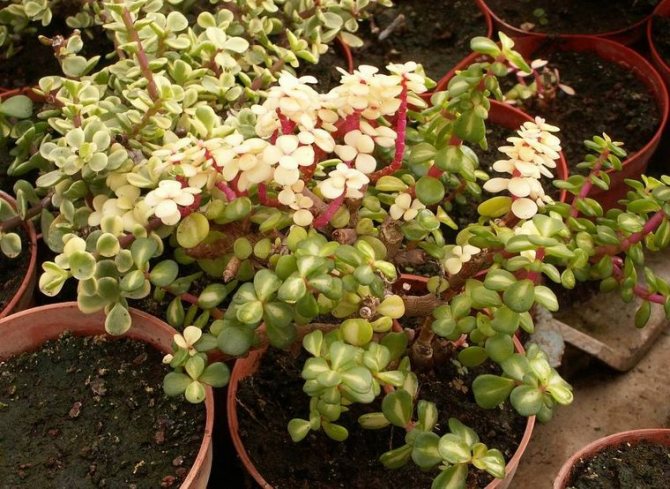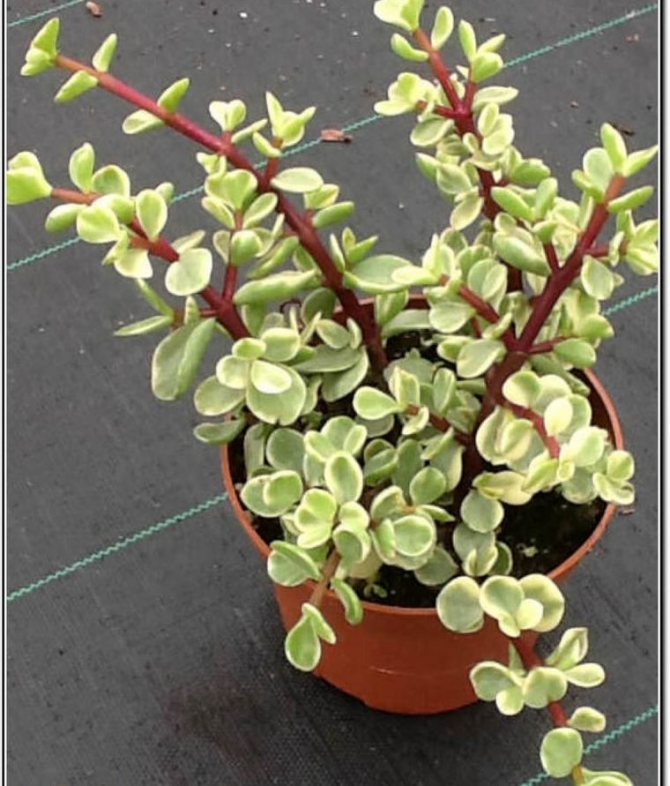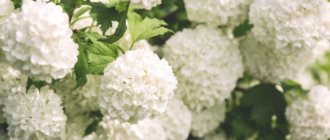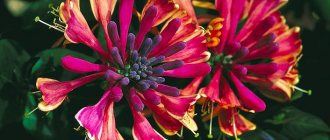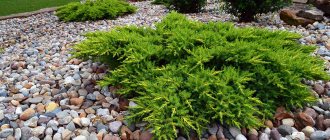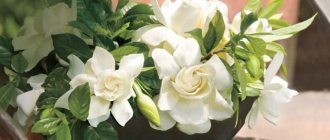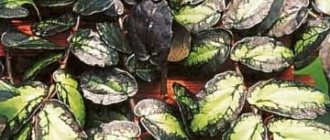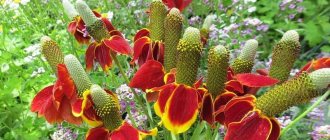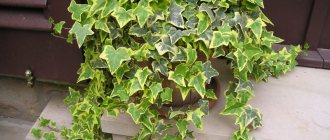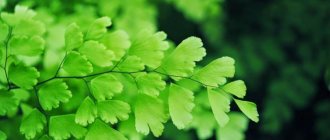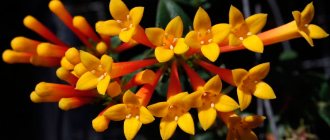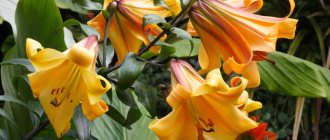Portulacaria is a perennial, succulent plant that forms an attractive bush or small tree. It is easy to cut and form a crown, therefore, in the photo, the portulacaria is often depicted in the form of a bonsai. Florists love this unpretentious plant for its undemanding nature and graceful forms. It lives in the arid prairies of South Africa.
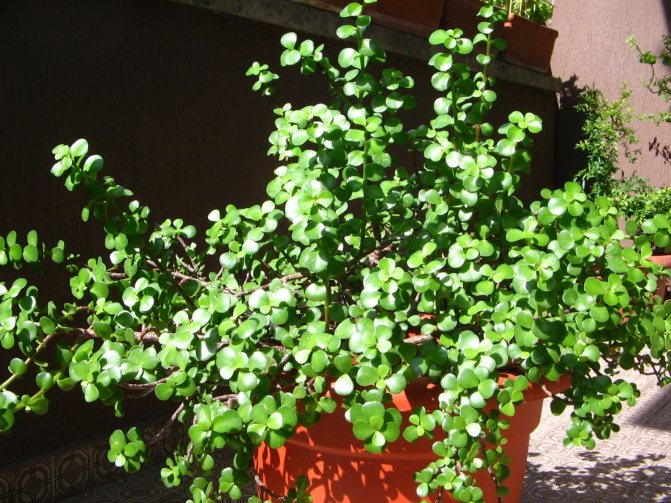
Description
The roots are powerful, feeding the plant even under unfavorable conditions. Shoots are rather thick, light brown or gray in color, but darken with age. Leaves are round, dense, green, 2-3 cm long, 1 to 2 cm wide.
Portulacaria well accumulates moisture in the leaves. It is easy to restrain and shape it.
Succulents are not commonly used for bonsai. The exception is African Portulacaria (portulacaria afra), only this species is suitable for home breeding. In native Africa, it reaches a length of up to 3 m. It has a wrinkled, brown trunk, juicy green leaves. Flowering in nature can be observed infrequently.
For a change, varieties were bred from this species:
- Portulacaria African motley form (variegated) - shorter than the previous species, the leaf is juicy green, with snow-white stripes along the edge. In low light, variegation disappears. If the plant has enough light, then Portulacaria is motley medium-sized, with a dark trunk, small leaves.
- Portulacaria African form variegated cultivar (Tricolor) - medium-sized, with small leaves and variegation in the center of the leaf. Under normal lighting with a red trunk and leaves with a pink tint, if there is not enough light, the variegation disappears, along the edge there is a pink stripe.
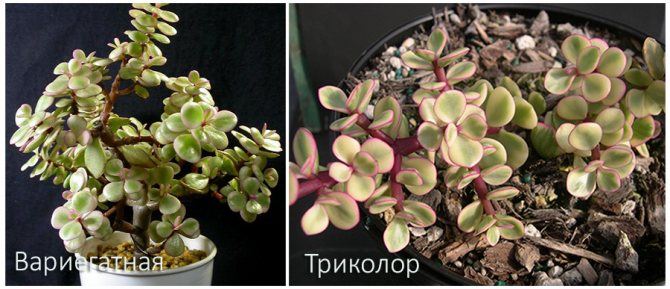

Planting and transplanting
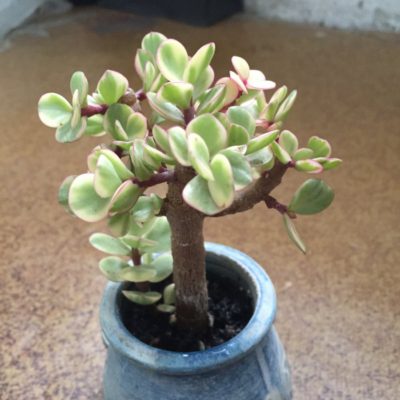

For this crop, you can use the soil for cactus, where there is clay and sand. It is sold in flower shops.
You can also prepare soil for succulent yourself. To do this, in equal proportions, sand, charcoal, garden and leafy soil should be mixed.
All ingredients must be purchased from a specialist store.
But before mixing, the sand and soil are recommended to be placed in the oven for 1.5 hours.
For drainage, it is useful to pour small stones or brick chips into the pot.
REFERENCE! With proper pruning, bonsai can be grown from the plant.
A young plant must be replanted every 2-3 years, then the soil must be changed. An adult portulacaria is transplanted every 5-6 years. If you do not follow this procedure, then the plant will not have enough space, the root system will be injured and this will lead to disease.
When transplanting, you need to take a pot with a diameter of 2-3 cm larger than the previous one. You can also limit yourself to trimming the roots and changing the substrate, and leave the capacity the same. The pot should be taken heavy with a wide bottom so that the plant, stretching towards the light, cannot tip over.
Reproduction
Breeding purslane is very simple. Due to the fact that its shoots are easily rooted, you can get your own breeding material and carry out various experiments with the creation of various forms of bonsai. Cuttings can be made from cut branches. It is important to leave 2-3 leaves on each cut. Shoots are cut at the base of the leaf, dried for a day before planting, the bottom leaf is torn off.
First, the cuttings are planted without a cap in separate pots, pre-filled with soil that is used for adult plants, mixed with sand.
For good rooting, you need to provide lighting and a constantly slightly moist soil.
Characteristics of portulacaria
| Genus | Purslane |
| Family | Purslane |
| Homeland | South Africa |
| Escape type | Direct |
| Inflorescence | Grozdevidnoe |
| Petal color | Pale pink, yellow |
| The structure and color of the leaves | Elliptical, light green |
| Flowering period | Blooms very rarely |
| Fetus | Achene. Rarely formed |
| Reproduction | Seeds, layering, cuttings |
According to its botanical characteristics, Portulakariya (Portulakariya) is a shrub or a small tree that looks very similar to a fat woman, with a smooth trunk capable of holding water for a long time, with wrinkled bark. The trunk usually stretches towards the light and gradually takes on an unusual shape. A large number of shoots develop on the trunk. At a young age, the color of the bark of the plant varies from burgundy to crimson. Over time, it takes on a brown color.
At home, the portulacaria is capable of reaching 350 cm in height. At home, it grows into a small tree.
The plant has a powerful, rapidly growing rhizome of light or dark brown hue, which supplies the bush with nutrients even in harsh conditions.
Platinum leafs are round or elliptical, juicy, with a smooth surface, shiny, pale green hue, oppositely located, up to 3 cm long, up to 2 cm wide. A large amount of moisture accumulates in the leaves, therefore they are thick and fleshy. Thanks to this feature, the plant can do without watering for a long time. Leaves are formed only on new shoots. There are forms with variegated foliage.
The inflorescences are aciniform, about 9 cm long, formed in the upper part of the shoots, consist of five-petal flowers 2.5 cm in diameter, light pink or yellow in color.
During flowering, a huge number of small buds with a light pleasant aroma appear on the purslane bush. However, at home, a succulent rarely pleases flower growers with flowering.
Growing problems - table
| Problem | Cause |
| The flower begins to shed its leaves. | Insufficient or reduced lighting in winter. |
| Excessive elongation of the branches. | Lack of light or excessive moisture. |
| Yellow and withered leaves. | Waterlogging. |
It is necessary to smoothly transfer Portulacaria to a new irrigation regime associated with the change of seasons. It is necessary to provide light moisture to the soil in order to prevent sudden changes in the level of moisture and dryness. This succulent plant is not afraid of dry climates, it does not require spraying or humidification of the air. Foliage stains can be wiped off with a dry soft brush.
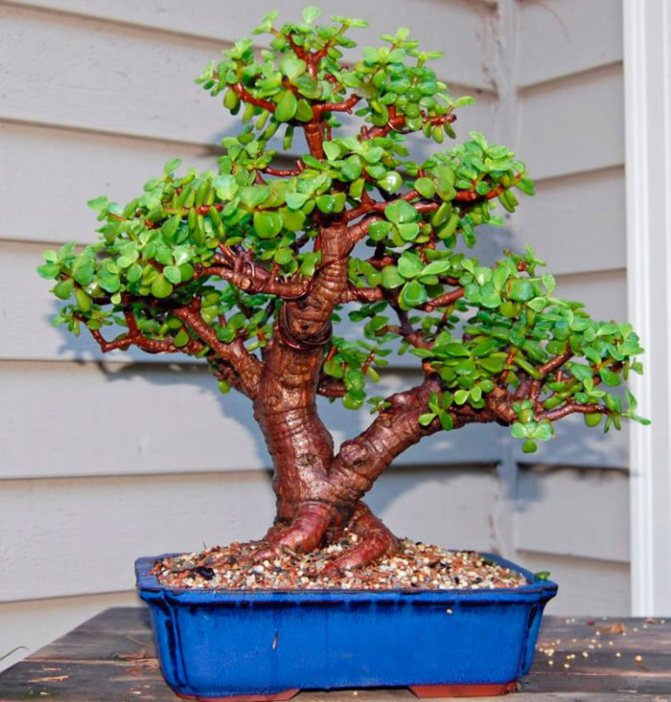

A kind of plants like portulacaria (Portulacaria) is directly related to the purslane family. In nature, such a plant can be found in the arid hot regions of South Africa. According to data from various sources, this genus combines about 5 species or is monotypic, that is, it is represented by only 1 species - portulacaria african (Portulacaria afra), which is also called "elephant bush".
Portulacaria African is a strongly branching woody shrub that can reach a height of 3.5 meters. It has a few chaotic shoots and thick, fleshy stems. Young stems are colored purple-red, but over time they become covered with wrinkled dark brown bark. Short internodes, while the nodes are clearly visible. Peteless, oppositely located, juicy leaves are relatively small in size, so, in length they reach from 2 to 3 centimeters, and in width - from 1 to 2 centimeters.The wide-oval shape of the leaves has a slightly pointed tip. Abundant flowering. The flowers are small (2–2.5 mm in diameter), five-petal, pink in color. They are collected in axillary inflorescences that have the shape of an ear and reach a length of 7.5 centimeters. Such inflorescences are located at the tops of the shoots.
The original appearance has pale green foliage. But there are forms with a purple-pinkish edge of the leaves. Also, on the surface of the sheet plate, there can be wide light spots that do not have a shape, which in some cases almost completely discolor it.
Intemperate succulent plant for bonsai
Indoor bonsai are mainly represented by the familiar gigantic shrubs and trees, which in nature and in gardens are associated with oriental design. But there are exceptions among bonsai. Portulacaria can rightfully be ranked among the unique plants - a fast-growing and surprisingly spectacular succulent, which began a completely new career as a bonsai. Portulacaria are not very popular not only in floriculture, but also in landscape design. And they can be found only in the form of bonsai and very rarely in ampelous culture, but in this capacity they will outshine even the most eminent competitors.
Portulacaria is often associated with the Portulac family, but the plant has long been transferred to the genus of perennial succulents Didiereus, whose representatives in room culture can be counted on the fingers. Portulacaria are represented by one and only species. This amazing plant from the number of giant succulents came to us from the African deserts. Adaptation to the most extreme conditions on the planet, even in the form of a bonsai, it can be considered an extremely unpretentious plant.
African portulacaria (Portulacaria afra), despite the ease of formation and control, is considered one of the largest species of bonsai. Young portulacaria 15-20 cm high quickly transform into seemingly ancient multi-stemmed trees with a height of 50 to 80 cm.In nature, this shrub with gradually woody, fleshy, drooping shoots and amazing bark can grow up to 3 m, striking in its size. No permanent formation measures portulacaria can grow up to two meters, so pruning is considered a vital measure: rapid growth needs constant monitoring. The bark of the portulacaria is very beautiful, with grayish-reddish shades, quite catchy, glossy. The most surprising thing about the plant is a red hue, the same tone, characteristic of both young twigs and a trunk with old bark. The only difference is that on the trunk, the bark gradually becomes more and more wrinkled. The shoots contrast with the greenery in such a way that they seem to illuminate the crown from the inside. The leaves of this unique bonsai are also fleshy, only about an inch in length, bright green, obovate, although visually appear to be flat, round discs. Sitting opposite leaves perfectly emphasize the drooping shape of the fleshy shoots. The elegant, curly, all consisting of small discs of the crown of the portulacaria looks amazingly impressive, and the light green color is combined with the bark of the tree just amazing.
In room culture portulacaria African almost never blooms. A plant only at a very significant age and under ideal conditions can please with single light pink flowers, but you can only admire this spectacle in botanical gardens.
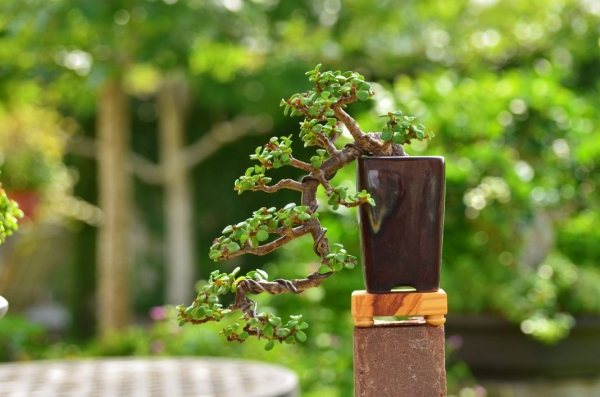

African portulacaria (Portulacaria afra).
Caring for purslane at home
This plant is distinguished by its unpretentiousness, so even inexperienced growers can easily grow it.
Illumination
In order for the plant to grow and develop normally, it needs good bright lighting, and at the same time, direct rays of the sun must be present. In this regard, a south-facing window will suit him perfectly. To form a beautiful uniform crown, you can resort to one trick. Namely, it is necessary to regularly turn the purslane pot in different directions to the light source.
In winter, such a plant will need additional lighting with special phytolamps.
Temperature regime
You feel quite comfortable in the mid-latitude climate in the summer. In the spring and summer, it is recommended to move it to fresh air (to the garden, to the balcony). It should be remembered that such a flower simply needs fresh air, therefore, when growing in a room, systematic ventilation will be needed.
Portulacaria needs a cool winter. In this case, it is necessary to ensure that the temperature in the room where the plant is located is not lower than 10 degrees. Otherwise, the fleshy leaves freeze and become lethargic.
How to water
Such a succulent plant is quite accustomed to arid climates, where rain is a comparative rarity. Therefore, when grown in room conditions, it should be provided with similar conditions. So, it is recommended to water it only after the soil in the pot dries out by 1/3 part. With a cool winter, watering should be more scarce and less frequent, because the root system and foliage, with excessive absorption of water, rot very quickly.
Why is it dropping leaves?
Insufficient lighting or excess moisture is considered the cause of leaf fall. This happens in the winter months. You do not need to worry about the health of the plant if the fallen is less than half of the foliage.
If the plant does not have enough light or excess moisture is present, this can cause loss of brightness of leaves, diseases and pests. With poor care from afra, it will not be possible to grow bonsai.
We also recommend you other articles about houseplants, for example, about such as: ficus microcarpa, brachychiton, episcia, tradescantia.
Botanical description
Portulacaria belongs to the Purslane family, there is only one plant species in its genus. It is a succulent evergreen perennial. Portulacaria rhizome is quite powerful, it is able to feed it even in extreme conditions. Above the ground are branched, fleshy shoots covered with dense, smooth bark. On young plants, the bark is colored light brown or gray, but gradually it darkens. The annual growth of shoots is insignificant, therefore, indoor purslane remains a compact bush for a long time, although in its natural environment it can reach a height of 2-3 m.
Leaves are found only on young branches. Leafless rounded or oblong foliage has smooth edges. The length of the leaves is 2-3 cm, and the width is 1-2 cm. The leaves are thickened and covered with a dense, waxy skin of bright green color.
Flowering occurs in February-April. Axillary, spike-shaped inflorescences appear on young branches. They are composed of many white and pink five-petal flowers that resemble small stars. The diameter of the flower is 2.5 cm, and the length of the entire inflorescence does not exceed 7-8 cm. In place of flowers, juicy berries with a pink skin later ripen. In nature, they, along with leaves, serve as food for elephants and other animals. Flowering can be regular only in mature plants in natural conditions. Indoor portulacaria rarely delight the owners with flowers.
Pests and diseases
Due to the structure of its foliage and the lack of flowering, the plant has strong immunity. Therefore, afra copes with many diseases and harmful insects. Only mealy worms, aphids and scale insects can harm her. Decoctions and infusions of useful plants will not help here. To get rid of pests, it is necessary to use insecticides.
Portulacaria diseases include:
- Foliage withering.This comes from excess moisture. Foliage recovers on its own when it is properly watered.
- If there is not enough light, and there is a lot of moisture in the soil, then the shoots are stretched.
Known varieties
According to botanists, there is only one species in the genus of Portulacaria - African portulacaria or Afra... In nature, it is a tall shrub or succulent tree with a spreading crown. Its height can reach 3.5 m. The leaves are tear-shaped and light green. The surface of the fleshy leaves is monochromatic, covered with a shiny skin. Smooth grayish stems become covered with wrinkled dark brown bark with age.
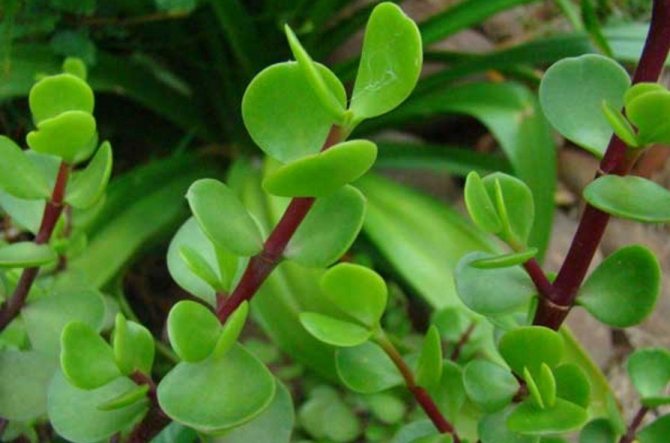

To diversify the offer and allow flower growers to buy purslane with a more interesting appearance, botanists have produced the following varieties:
- Portulacaria variegated.The plant does not exceed 1 m in height. The oblong leaves in the center are painted bright green, and along the edge are edged with a silvery stripe. Many thin, perpendicular strokes are drawn from the edge to the core.
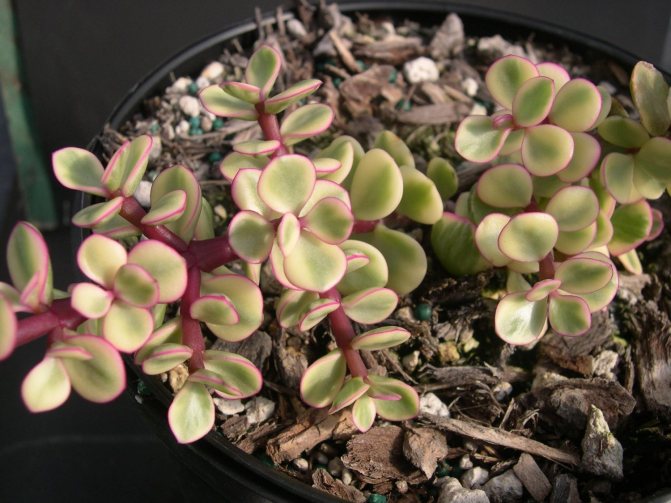

Types and varieties with photos
There is no consensus as to how many species are in this genus. Some distinguish 5-7 species, while others consider the genus mototypic, that is, represented by only one species, namely the Afra portulacaria.
Portulacaria Afra
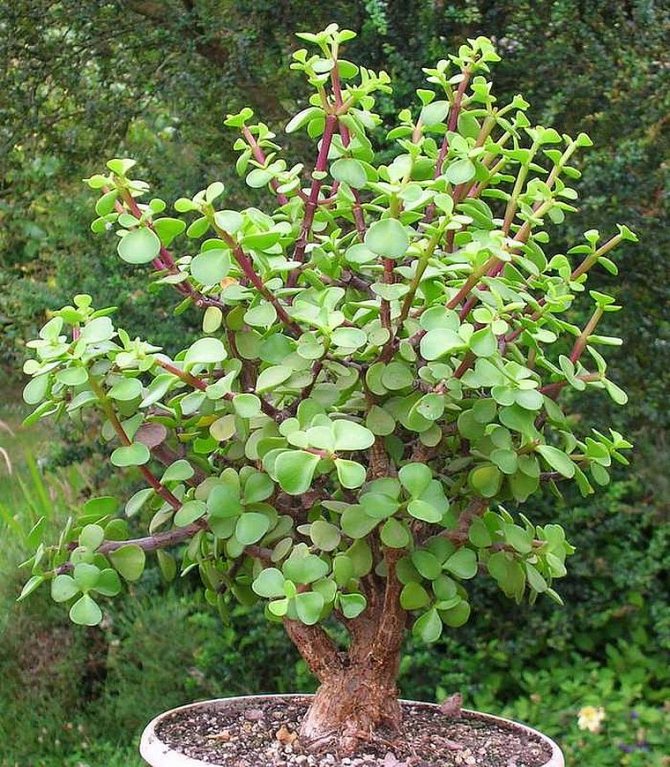

Portulacaria afra or African (Portulacaria afra) is a strongly branching woody shrub that can grow up to 3.5 meters. It is also called the elephant bush.
In the photo portulacaria afra bonsai:
Portulacaria afra variegata or variegata (afra variegata) is a short, unpretentious plant that differs from the natural species in the color of its leaves of light green color with a light gray border and longitudinal blotches of this color. It grows no more than 1 m in height. The stem is red-brown.
Portulacaria variegated tricolor - the leaves are small, with a light green colored middle and a light thick border along the edge (beige or silvery), behind it, on the edge of the leaf, the color changes to light pink or light crimson. The stem is bright pink or dark pink.
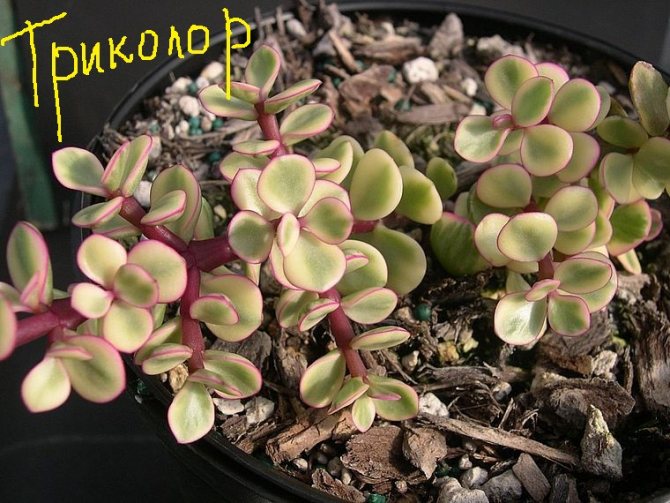

Here are what other varietal varieties exist according to Wikipedia, some are bred when grown, others naturally:
- Limpopo - This variety has large leaves.
- Prostrata: low-lying, delayed form, often used as a ground cover.
- Aurea: A compact cultivar with rounded leaves with a yellow color.
- Foliis variegatus is a variegated variety.
- Medio-picta - variegated with a lighter center.
Portulacaria armiana
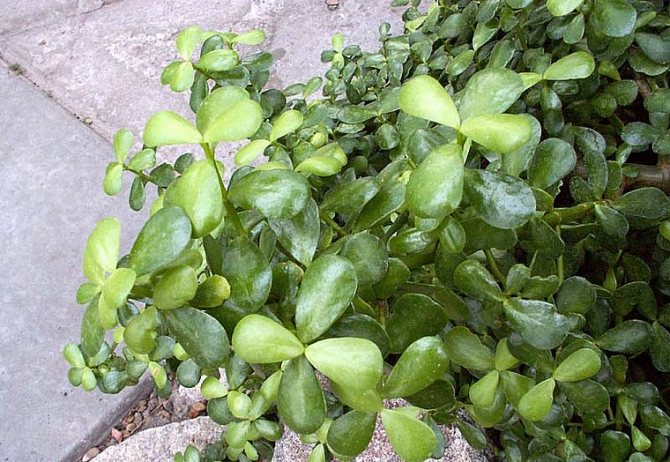

P. armiana - this shrub is distinguished by large green-gray waxy leaves, high panicle inflorescence.
Portulacaria carrissoana
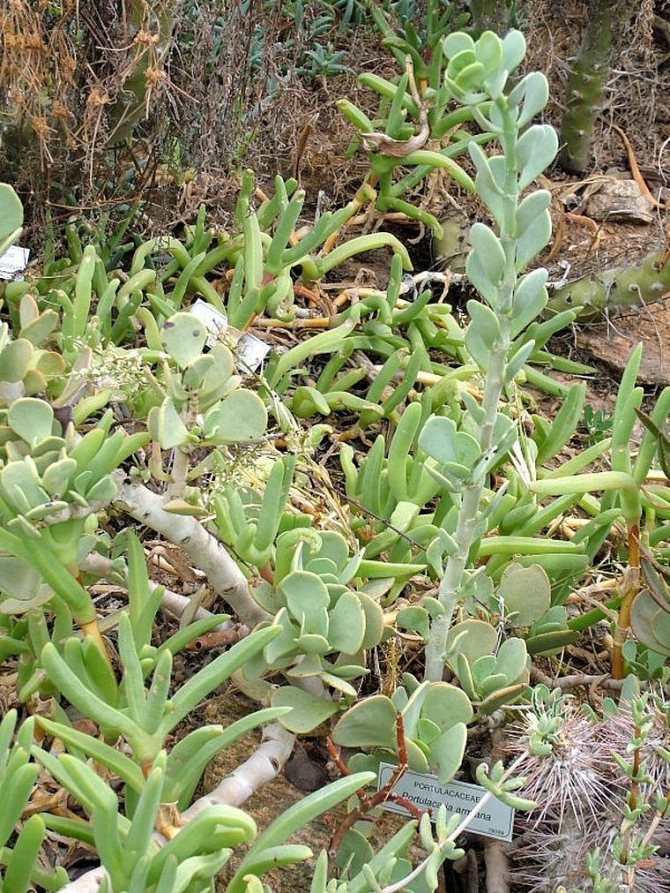

P. carrissoana is a soft shrub with flat, round leaves and bisexual flowers.
Portulacaria fruticulosa
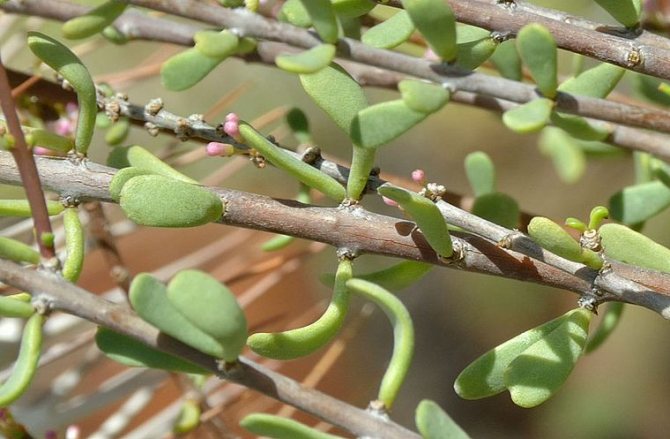

Portulacaria fruticulosa is a soft, deciduous shrub with flat, round, succulent leaves. Bears bisexual flowers on sessile inflorescences.
Pygmaea
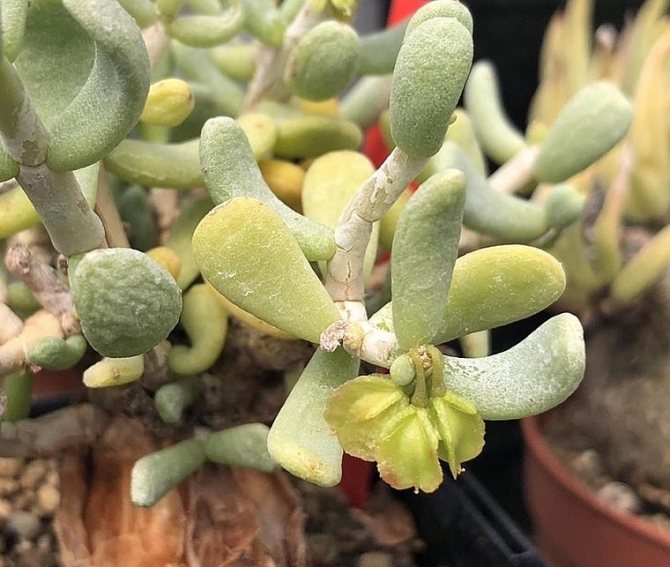

Portulacaria pygmaea is a compact, dwarf shrub with unisexual flowers, green-blue leaves. The compact branches spread out and often hang down.
Namaquensis


Longipedunculata


Reproduction methods
Reproduction of portulacaria is carried out by vegetative and seed methods. For rooting, cuttings are cut into thick stems 12-15 cm long, they must have at least four leaves. The cut is made at an angle with a sharp blade. The place of the cut is sprinkled with crushed charcoal and left to air dry for 7-14 days. When the cut is covered with a thin film with whitish spots, the cutting can be planted in a moistened sand-peat mixture.
While rooting takes place, the seedlings must be kept in a bright room with an air temperature of + 25 ° C. This process usually takes about a month.Cuttings can be transplanted to a permanent place only 2 months after planting in the ground.
You can speed up and simplify the rooting process using the layering method. Without separating the stalk from the mother plant, it is pressed to the ground. After the appearance of young roots, you can cut off the shoot and transplant it into a separate container.
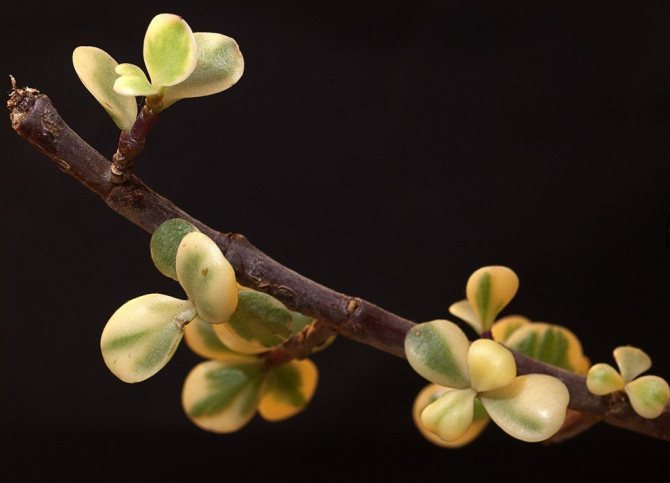

Growing seedlings from seeds is also quite simple. This method allows you to get a large number of plants at once. It is enough to sow the seeds in a mixture of sand and peat and cover with foil. The greenhouse should be ventilated and the soil should be moistened as it dries. After 2-3 weeks, the first shoots appear, and after another month the seedlings can grow independently and without shelter.
Breeding tips for African portulacaria
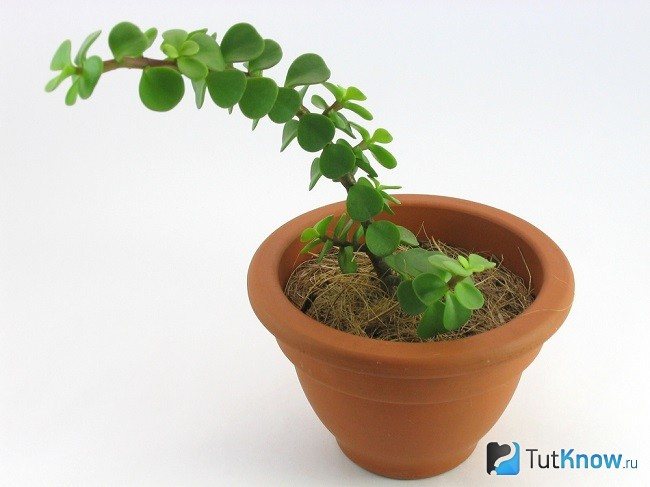

The plant can propagate by seed, cuttings or layering.
If the seeds were obtained or bought, then they must be planted immediately, since their germination is quickly lost (literally several months). Seed material is planted in moist peat with the addition of perlite or other baking powder. The soil mixture must be placed in a shallow container, planted, and sprayed. Then the container with the seedlings is covered with a plastic bag or a piece of glass to create the conditions for a mini-greenhouse, where there should be constant temperature indicators of heat and high humidity. Germination takes place at a temperature of 24-28 degrees. It is necessary to periodically open the container to ventilate and moisten the soil. It is necessary to put the container with seedlings in a place with diffused soft light. As soon as the seedlings appear and the plants get stronger, they can be planted in separate pots with a diameter of no more than 7 cm. The soil is taken as for adult specimens. Using this method, portulacaria rarely reproduces.
They begin to engage in cuttings from the middle to the end of spring. You can use the branches left after the next pruning of the mother plant. For cutting cuttings, it is necessary to choose sufficiently thick shoots, which measure 12-15 cm in length and have at least 4 pairs of leaves on them. It is recommended to cut obliquely. For successful rooting, the branches are dried for 10 days. Then the leaf plates, which are located at the bottom of the cutting, must be removed so that there is a distance of at least 7–8 cm from the lower end of the branch to the first leaves. As soon as wrinkles and whitish spots appear at the cut, this signals that root formation has begun. After that, in a plastic pot, which does not exceed 5 cm in diameter, a soil mixture based on peat and sand (or any other soil loosening agent) is poured. Then the substrate is moistened by pouring about a quarter of a glass of water into the pot, allowed to soak and dry a little. A deepening of at least 7.5 cm is made in the ground and a prepared branch of portulacaria is planted.
Now it is necessary to put the pots with young plants in a place with good diffused illumination and it is important that the soil temperature is maintained within 20-25 degrees. The stalk releases roots and takes root within 2–3 weeks. After that, the matured plants are transplanted into pots with a diameter of 9 cm into the substrate in which adult portulacaria grow. If it so happened that before planting, the cut began to turn black, then this indicates decay of the cutting, it is necessary to cut the twig by half a centimeter, treat the tip with crushed activated carbon, which will disinfect and prevent subsequent decay. After a while, you can try to root the portulacaria again.
There is another method for propagating this tree - the use of air layers. It is necessary to choose the branch that is the longest and it is possible to bend it to the soil of another pot (or into the ground of your own).If it is decided to carry out rooting in another container, then it is necessary to prepare in advance a pot with a diameter of no more than 7 cm and fill it with a peat-sand mixture. The selected shoot is carefully folded down and attached to the ground with a piece of bent wire or a hairpin. When roots appear on the branch that was used as a layering and clear signs of development are visible, then it is carefully separated from the mother's purslane. As soon as the new plant grows confidently, it will be possible to transplant (preferably in the spring months) into a larger pot with a substrate suitable for further growth.
Care rules
Caring for purslane is not difficult. It is used to the harsh conditions of the hot prairie and is therefore a very undemanding plant. Portulacaria needs bright lighting, direct sunlight is simply necessary for the leaves. The tough skin is resistant to burns, so there is no need to worry about their condition. You can safely put the pots on the windowsills of the southern rooms. In order for the crown to develop evenly, it is recommended to periodically rotate the plant.
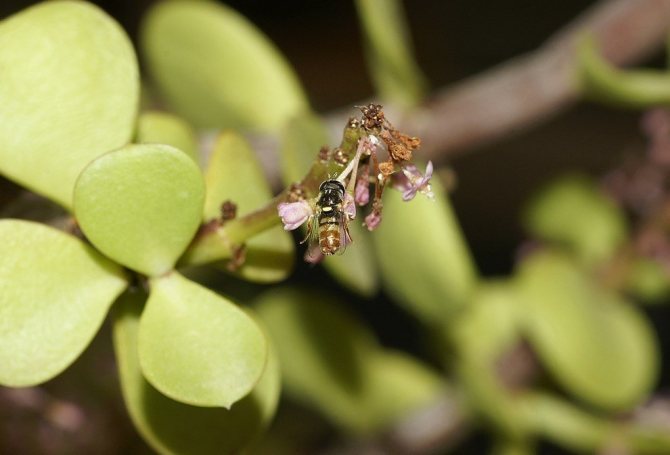

Portulacaria normally perceives summer heat. It is recommended to ventilate a stuffy room more often. You can take out a pot with a plant in the garden or on the balcony for the summer. In winter, a slight drop in temperature is allowed, but a cold snap below + 10 ° C will lead to the death of leaves and the death of a tree.
Watering purslane should be done with care. For irrigation, use warm water without chlorine. Rigidity does not play a special role. The soil should dry out almost completely between waterings. Succulent stems store enough water to prevent the plant from dying, even in severe drought.
Air humidity for purslane does not matter. It normally exists near batteries and near the aquarium. In high humidity, air roots may appear on the stems. From time to time, you can rinse the shoots in the shower to get rid of the dust.
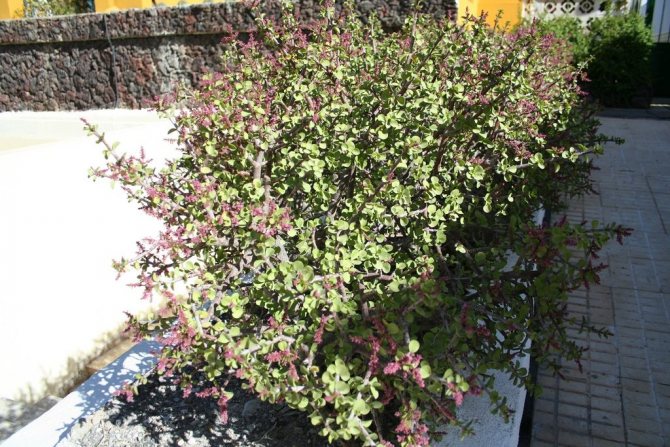

In the spring and summer, it is useful to fertilize purslane. For this, feed for succulents with a low nitrogen content is used. Fertilizer is added to the water for irrigation, otherwise you can burn the roots.
Transplanting is performed quite rarely, since the portulacaria slowly builds up the root mass. When the rhizome takes up free space, the earthen lump is carefully transferred into a new pot. It is impossible to take a large tub at once, this will provoke decay of the rhizome. A thick layer of drainage is placed on the bottom of the container. The soil for planting should contain the following components:
- river sand;
- garden soil;
- leafy soil;
- charcoal.
You can buy ready-made cactus soil from the store and add a little sand to it. The reaction of the soil should be neutral or slightly acidic.
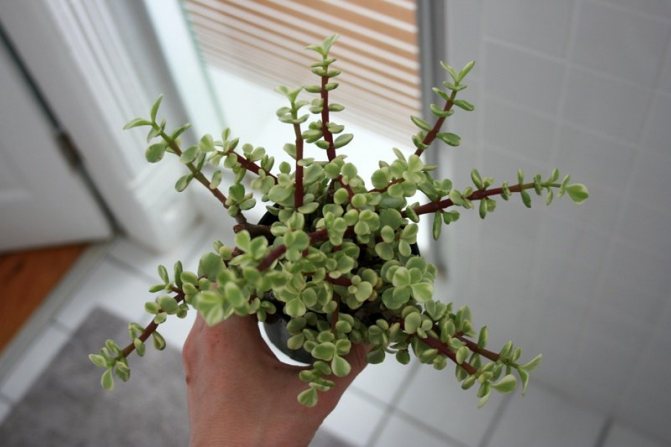

Portulacaria afra. How to care
Portulacaria afra (Portulacaria afra)
Portulacaria afra is the only species of this South African genus that is cultivated at home. It is a slow growing, undersized succulent that can be used to form a bonsai-style tree. At the age of 5 to 10 years, it is only 12-15 cm high.
The yellow flowers of the plant are similar to those of the groundwort and are similar to a poplar, but at home the Afra purslane blooms extremely rarely. It is grown for its beautiful leaves, which are especially good for the variegated form.
The plant looks great both in a regular low pot and in a hanging basket.
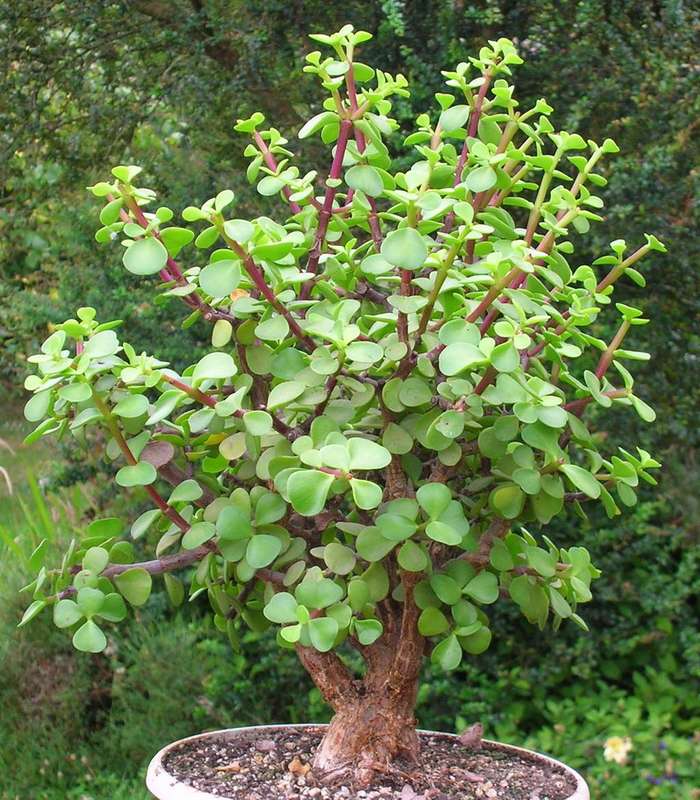

Portulacaria afra. Care
Illumination: full illumination. For good development, the plant needs sunlight every day for at least 2 hours.
Temperature: in winter - not lower than 4 ° С. Provide fresh air in summer.
Watering: Water the plant every 2 weeks in the spring and summer, and weekly in the hottest weather. Reduce watering in fall and water only once a month in winter to keep the soil from drying out.
Top dressing: apply fertilizers with a high potassium content 2-3 times over the summer.
Soil: fertile clay mixture for indoor plants or soilless substrate with the addition of 1/3 coarse sand.
Transplant: transplant a young plant every spring; after the tree trunk reaches a height of about 20 cm, do not replant for 2-3 years. After transplanting, do not water the plant for 2 weeks; be careful not to damage the leaves as they are very fragile.
Reproduction: cuttings. The plant also reproduces by seeds, but they are very rarely found on the market. When growing from seed, water the plantings regularly from below. Place the pot or container in a pan of water and wait until the soil surface is moist. Then it is necessary to allow the water to drain to provide air access to the roots of the seedlings. For the first 6 months, the tiny seedlings should not be too dry.
Portulacaria. Care features
Cuttings. In spring or summer, use a sharp knife to cut off part of the branch just below the lowest leaf remaining on the cutting. Sprinkle root hormone powder on both the cutting surface and the stem and place the cutting in an empty pot for a few days to dry. Then plant in dry potting soil. Water after about 3 weeks when the plant starts to show roots.
We recommend watching:
Pleiospilos. Care
Gibbeum dispar, Gibbaeum dispar
Hello everyone. Finally, I can ask for advice from the masters, in connection with the end of the move. =) I have purslane Afra, I think she is 2 years old. I read all the topics about her on the forum (if not all, then the majority). There weren't very many of them. I hope you will not refuse help. Portulacaria used to be in a pot, the substrate is unknown. I think ordinary, earth, humus, and minerals. Now, on Saturday, I transplanted it to the Akadama, cut the roots a little. Lighting further .. Concerning lighting: 1. Portulacaria stands almost on the windowsill. Receives direct sunlight, about 4 hours, from 8-12. Then just daylight illuminates, without direct sunlight. In winter, it was illuminated with a fluorescent lamp somewhere from 18-22. Now I think to stop, with the arrival of spring. I also consulted with one specialist, he said that he was accustomed to sleep in winter, and in summer there is enough sunshine. Maybe, too, it is worth removing additional lighting, will daylight be enough? 2. If you need additional lighting, then you need to be guided by the general rules for lighting flowers, or are there any peculiarities in lighting for purslane? Regarding some deviations on the leaves: 1. There are some brownish irregularities. On the old leaves that were before me (IMG :) They don't seem to appear on the new ones, I thought it was burns, but I strongly doubt it. Can you help me figure it out? (Figure 1). 2. Besides brownish specks, there are similar but slightly different anomalies. Slightly darker, at the ends of the leaves, rounded in shape, as it were. I strongly doubt the presence of pests. It is not massive, and mainly on old leaves, although they seem to appear on new ones too (I will post a picture with them in the topic below).
Light up a little, sorry. I think you can see brown spots =) This is how the bonsai itself looks like (if you can call it that, I haven't cut it yet). This is why there are some questions. Someone can advise some resource where you can read about the features of pruning Afra portulacaria, or maybe describe it here. I'll be very thankful. I'm not good at it, I'm afraid to touch the tree. (IMG:
Portulacaria (Portulacaria) is a member of the Purslane family. According to some sources, the genus has as many as five species, and according to others, it is monotypic, i.e. contains the only species of African portulacaria (Portulacaria afra).The plant is also called an elephant bush, due to its massive appearance.
In its natural environment, purslane can be found in the hot and arid regions of South Africa. But she perfectly "learned" to survive in such unfavorable conditions.
Portulacaria African is a shrub up to 3.5 m high. Stems and shoots are fleshy, gradually lignified, they grow in a chaotic manner. The emerging young shoots are covered with a lilac-red bark, but later it becomes wrinkled and takes on a dark brown tint.
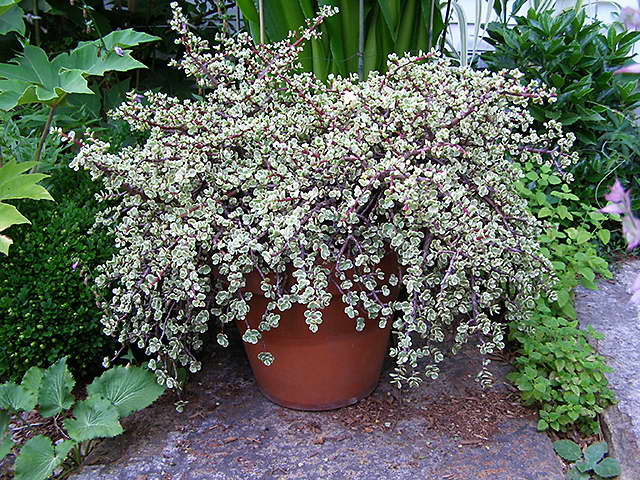

Portulacaria African variegated in a flowerpot photo
Leaf plates are petiolate, fleshy and juicy, broadly oval in shape, with a slightly pointed tip. The leaves are small: they are 2-3 cm long and extend a couple of centimeters in width.
The shade of leaves in the original species is pale green, but there are forms with other colors. In some, the edge of the leaf has a purple-pink hue, in others, the surface is decorated with light shapeless spots, which can merge and completely "discolor" the leaf plate.
Flowering portulacaria
Portulacaria flowers are small (2-2.5 mm in diameter), consist of 5 petals, have a pale pink tint. They gather in an inflorescence-spike with a length of 7.5 cm. The inflorescences are located on the tops of the shoots or in the axils of the leaves.
Thus, purslane has the appearance of a small flowering tree; it is often used in creating a Japanese-themed interior.
Possible difficulties
Portulacaria has strong immunity, rare difficulties may be associated with improper care:
- loss of variegated color or yellowing of the leaves occurs due to lack of light;
- the stems are strongly stretched with an excess of nitrogenous fertilizers;
- the blackened base of the stem, along with drooping leaves, indicates the development of rot due to an incorrect watering regime.
Sometimes on the succulent foliage you can find traces of parasites. This happens especially often with plants in the open air. If scabbards, mealybugs or spider mites are found, it is recommended to treat the shoots with an insecticide.
The best varieties of portulacaria
Several varieties of portulacaria are known in floriculture:
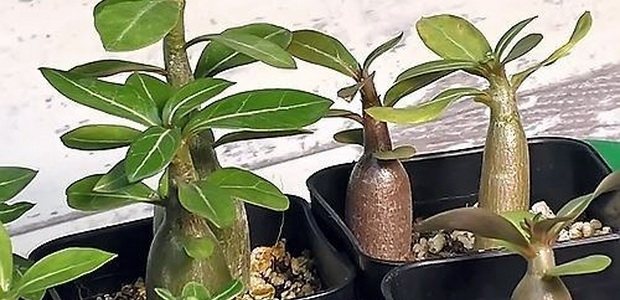

Limpopo - differs in larger leaves than in other species and varieties of this culture;
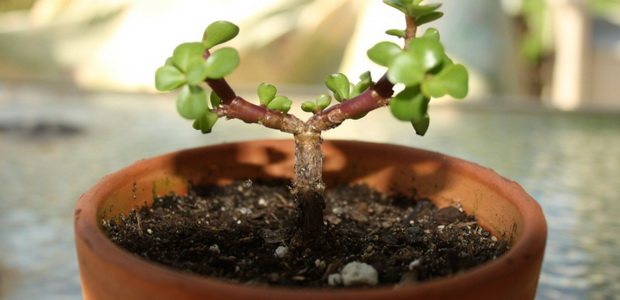

"Aurea" - miniature bush with yellow teardrop-shaped leaves;
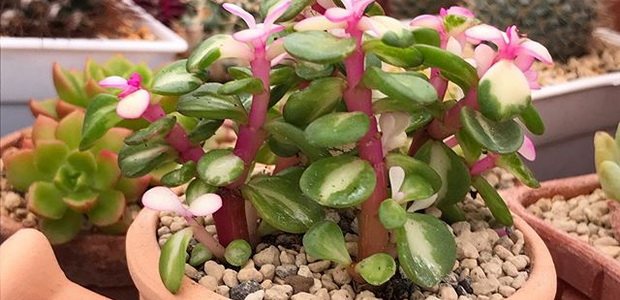

"Foliis variegatus" - one of the most decorative varieties of portulacaria, characterized by variegated foliage;
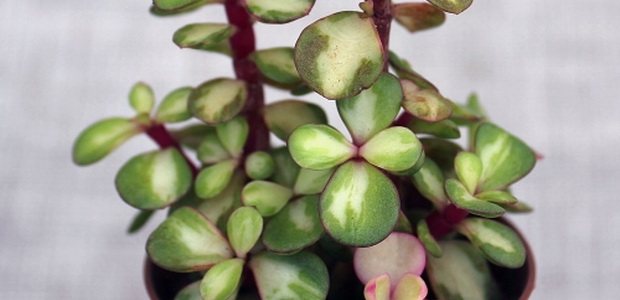

"Medio-picta" - variegated variety with a pale green central part of the leaf;
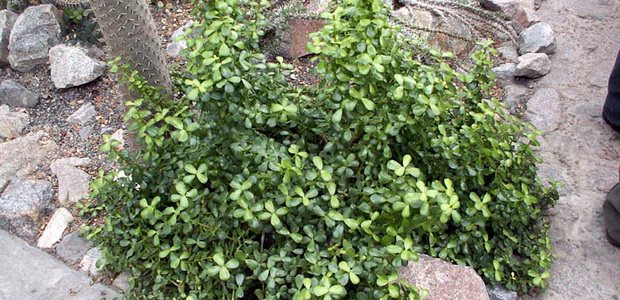

"Armiana" - a plant with rounded gray-green glossy leaf plates;
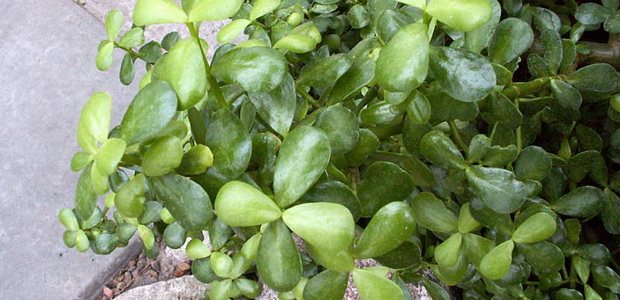

"Carrissoana" - a compact bush with obovate flat light green leaves;
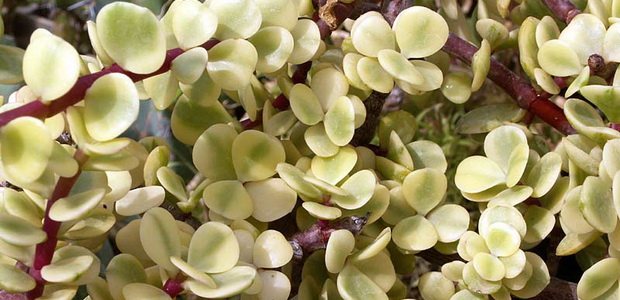

"Fruticulosa" - a small tree with a spreading crown and rounded flat leaves of a light green hue. The flowers on the plant are bisexual;
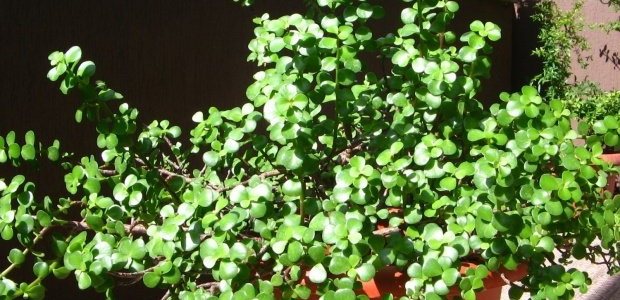

"Pygmaea" - dwarf variety with short hanging brown shoots and bluish-green teardrop-shaped leaves;
Top dressing
Top dressing of African portulacaria can be done in two ways:
- Once a year. It is carried out during the period of active growth with mineral fertilizers. The dosage is full, standard, as indicated on the package.
- 2 times a month during the spring-autumn period (approximately April-October). For this, fertilizers with a low nitrogen content are used, consuming ½ the dose per irrigation recommended by the manufacturer.
Liquid fertilizers for cacti and succulents, sold ready-made in flower shops, are ideal for feeding.
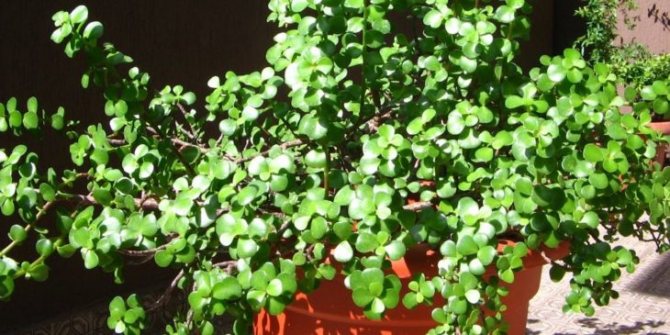

Where can one buy
Adult purslane plants, formed bonsai or seeds can be purchased from specialized nurseries, online stores or garden centers, but they are not common. The price for such copies is from 100 rubles. up to 1.5 thousand rubles.Cuttings are often offered by flower lovers in various forums or sold through social networks or through Avito, E-Bau, Yula message boards.
Online stores where you can buy purslane:
- luxuryplants;
- shopflowers;
- cactusenok.
Watering
As for watering, the rule is that a deficiency is better than an excess. Portulacaria perfectly tolerates drought and is desperately afraid of waterlogging. The plant should not experience drastic jumps in dampness and dryness, especially during the transition from winter to summer watering.
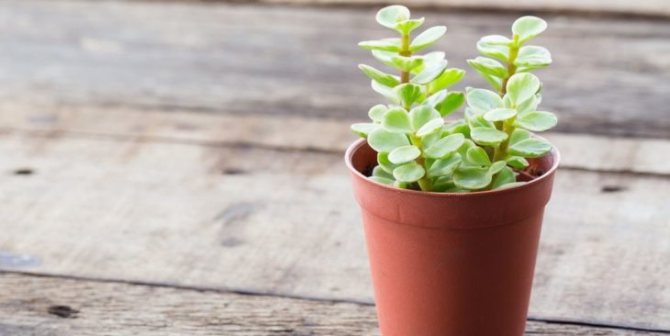

In winter, it is enough to maintain only light soil moisture, and not in a constant mode, but letting it dry completely between waterings. In summer, a little more moisture is added, but taking into account the fact that not only the top layer of the earth should be dry, but almost the entire depth of the pot. Frequent but not abundant watering is recommended. Water may not settle if there is no chlorine in it, and the level of hardness does not play a special role.
The plant does not need additional air humidification, therefore, spraying is not carried out for it. Portulacaria can stand quietly on a windowsill, under which there is a battery, or next to a heater and not feel discomfort. Contamination from the leaves is removed with a damp cloth, napkin or brush, "showering" is undesirable in order to avoid excessive wetting of the soil.
Temperature regime
Portulacaria feels comfortable in a mid-latitude climate, where in summer the air temperature does not exceed 25-27 ° С. During the period of active growth, it is better to protect the plant from extreme heat by planning a transplant for the winter or spring-autumn period. Wintering is preferable in a cool place, the optimal temperature regime is 10-16 ° С, but not lower than 8 ° С. Otherwise, the leaves may freeze, become lethargic and wrinkled.
It is also important to remember that the flower must be provided with constant access to fresh air. If it is not possible to put the plant on a balcony, veranda, or to transport it to the summer cottage for the whole summer, then the room where the pot stands must be regularly ventilated. In winter, the purslane care scheme does not change - the room is ventilated daily, and the plant itself is protected at this moment from the cold air currents.
Conditions for keeping portulacaria
It is an easy-care, but capricious plant. Next, we will talk about how to grow it correctly, what you need to consider in order to achieve high results and get the perfect bonsai tree.
Lighting. When caring for purslane at home, it is important to remember that the shrub develops only in bright sunlight, which it should receive as often as possible. It is recommended to place the succulent in direct sunlight, it will only benefit from this, showing its decorative qualities as much as possible. The flower should always be in a room with good lighting, therefore, in winter, when daylight hours are reduced, you need to expose it on those window sills where it will receive as much light as possible, for example, on the southern, partially southern or, in extreme cases, western. Artificial supplementary lighting will not benefit the purslane flower, so there is no need for it.


Air temperature. The most comfortable room temperature for a tree is 22 - 27 degrees. However, this plant feels good even in extreme heat, the main thing is that it should not be constant. In winter, purslane is better to be in a cool room with a temperature of 8 - 15 degrees. In the summer, the plant is best kept outdoors. In the room where the succulent grows, air must constantly circulate. Windows should be kept open as often as possible.
Watering. This crop needs constant but moderate watering. Portulacaria is sensitive to waterlogging of the soil, so you should carefully monitor whether the earthen lump has dried well before moistening it.A succulent plant will tolerate prolonged drought much easier than excess moisture. He can do without water for a long time.
In winter, you need to water the plant 1 - 2 times a month, maintaining light soil moisture.
It is necessary to transfer the shrubs from the winter watering regime to the summer one slowly, gradually increasing the number of waterings and their volumes.
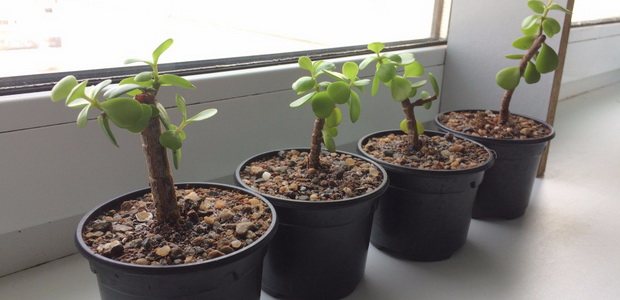

A succulent plant does not need high air humidity; when growing, spraying is not required. It is better to remove dust from sheet plates with a damp cloth.
Top dressing. When breeding purslane, there are several fertilization options. You can feed the plant at the beginning of the growing season using a complete cactus mineral complex. Many growers apply fertilizer several times a year from spring to autumn, doing this work 2 times a month. So they try to create more familiar conditions for the plant.
Formation and pruning of portulacaria. This plant easily tolerates pruning. In addition, it must be shaped in order to obtain the desired shape. This can be done at any time of the year, since the bush quickly recovers even after heavy pruning.
Since the succulent grows quickly, you should pinch it and cut off the elongated shoots regularly.
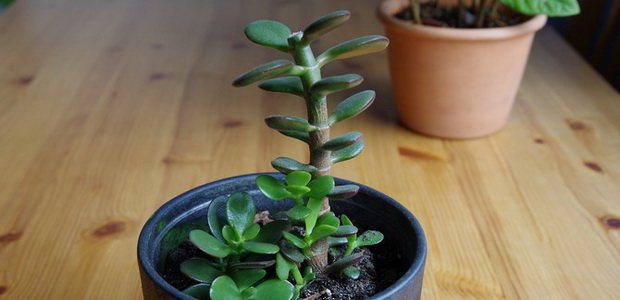

The best time for pruning is spring, and you can pinch the bush whenever you want. This will not affect his well-being in any way. If the grower does not neglect the formation, as a result, without much effort and the use of wire, which is usually used for bonsai, a shrub with a beautiful crown shape will be obtained.
Transfer. An adult succulent is transplanted only as needed, when its roots are completely entwined with an earthen ball and it becomes cramped in the pot. Young individuals need to be transplanted once every couple of years.
Massive tubs, large ceramic wide pots are suitable for this culture. The substrate is taken ready for succulents, or they make it themselves, mixing leaf and garden soil, river sand and charcoal. The soil for portulacaria should be loose, nutritious, slightly acidic or with a neutral reaction. At the bottom of the pot, a drainage layer 4 - 6 cm thick must be laid, using expanded clay, clay shards or other material for this.
In the process of transplanting, the roots are shortened by 1/3 to stop the intensive growth of the plant. The tree is removed from the old pot and placed in a new one, filled with fresh substrate, adding the required amount of soil to the voids and tamping it tightly.
Diseases
An important and convenient feature of succulents for the grower is the property not to get sick and practically not be exposed to pests. A weakened plant in rare cases can become infected with a spider mite and scabbard. To eliminate parasites, spray it with an insecticide solution from a spray bottle.
What to look out for when caring for a purslane:
- lack of light and air will lead to yellowing of the leaves and a change in their color;
- too long stems are formed due to an excess of nitrogen in fertilizers;
- drooping leaves and a black stem base indicate an excess of moisture and root rot.
If you create favorable conditions for the portulacaria, then the plant will grow and develop well.
Crown formation
Crown trimming can be done in any way, focusing on your own aesthetic preferences. Even if the pruning is too strong and not of very high quality, the plant tends to quickly recover and grow foliage. Such work is usually carried out in the spring during the period of active growth of the stems.
In addition to pruning, purslane requires regular pinching of young shoots. As a result, the plant is not “driven out” in height, but acquires a beautiful spreading crown.Restraining the growth of a flower by shortening the tops is also due to the impossibility of tying it to a wire. Supporting the branches in this way is too traumatic for the delicate, fleshy leaves, so it is best to use the pruning method when creating the shape.
Diseases and pests of portulacaria
Portulacaria Africanis are disease resistant (difficulties arise with inadequate care) and are rarely damaged by pests.
With excessive watering (especially in conjunction with a cool air temperature), rotting is possible. It is necessary to return the purslane to warmer conditions, temporarily stop watering, remove the affected areas and treat the plant with a fungicide.
Why do leaves fall?
In case of insufficient lighting, leaves may be dropped. If favorable conditions are created, the leaves will grow back.
Among the pests of portulacaria, there is a red spider mite (leaves small whitish cobwebs on the plant), a mealybug (its deposits look like cotton wool lumps) and a scale insect (dark "growths" can be seen on the back of the leaf plates). First, thoroughly rinse the plant under warm water, this is often enough, as a last resort, treat with an insecticidal preparation.
How to form a bonsai from portulacaria
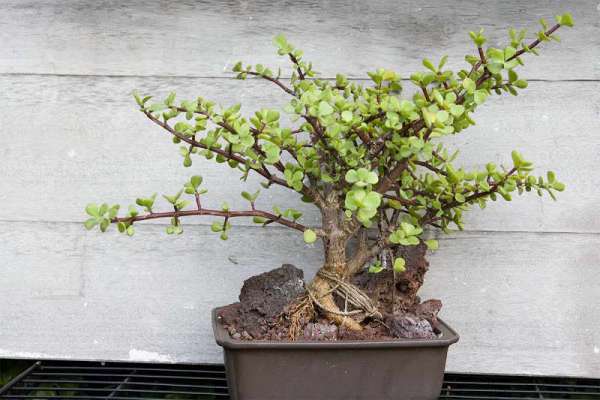

Bonsai from portulacaria how to form
Young twigs of an elephant bush are very flexible, and even bend under their own weight. It takes patience to form a bonsai. You will need to form a bush into one trunk, and then leave 3-4 main branches on it. for the trunk to thicken, it will take radical pruning every fall, so that in the spring the plant will release new young branches.
The trunk and main branches are fixed with thick wire and guide sticks in the desired direction, and when they become stiff, the auxiliary materials are removed. It is important not to pinch the branches too tightly so that the wire or rope does not cut into the bark.
Gradually, the trunk will thicken, and shape the crown at your discretion thanks to pruning.
Growing portulacaria from seeds
Portulacaria also reproduces generatively (by seed), but seeds are rarely found on the market. If you manage to get them, sow in a wide container with a loose nutrient medium.
- The seeds are very small and should be scattered over damp soil like salt.
- Cover the container with crops with glass or foil and place in a warm place (temperature range 22-25 ° C), provide diffused lighting.
- The shelter will need to be lifted daily for ventilation, periodically moisten the crops by spraying from a fine spray.
- When the sprouts appear, remove the shelter.
- Sow the grown portulacaria seedlings in separate containers.
Purchase rules and adaptation period
When choosing an indoor flower, attention is paid to its appearance. A healthy flower culture:
- bright saturated shade of foliage in the corresponding varietal variety range;
- there are no spots on the leaf plates;
- there are no signs of damage or rot on the roots.
A newly purchased plant is given the opportunity to adapt to new growth conditions for 2 weeks. During the adaptation period, it is not transplanted or fed.
The average price for a young portulacaria is about 100 rubles, for an adult bonsai tree - 1.5 thousand rubles.
Necessary conditions for growing
African portulacaria is not much different from other succulents in matters of care. It is quite unpretentious, rarely gets sick, and its crown is easy to cut, creating the shape necessary for design. Observing a number of simple rules, you can get an almost perfect bonsai without additional investment of time and money.
Location and lighting
Portulacaria grows in the wild in sunny Africa, so it needs bright lighting for proper growth and development.It is best to install Afra bonsai pots on the windowsills, or as close to the windows as possible, otherwise the plant will not have enough light.
Difficulties can arise with the creation of the correct temperature regime for the purslane. During the day, this plant loves hot, dry weather, and at night - cool. In order for the bonsai to feel as comfortable as possible, you need to cool the room with constant nightly airing, and keep the pot in the sun during the day. This should be done even in winter, because this type of succulent needs a lot of fresh air. In the cold season, you must not leave the pot on the windowsill while airing.
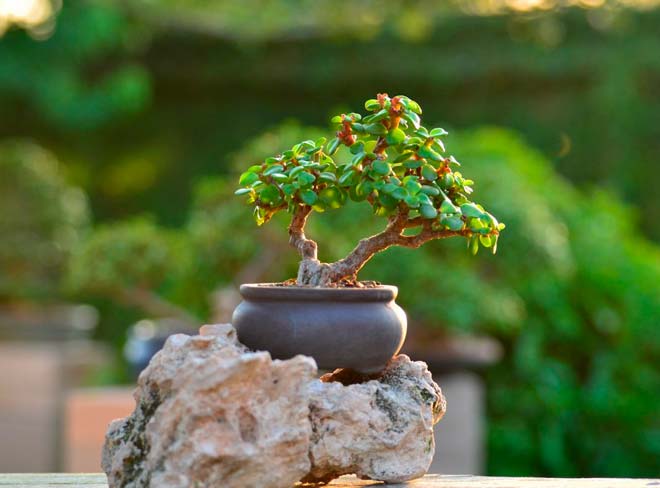

The plant hibernates in the cool. The ideal temperature regime for portulacaria is 13-16 degrees. If it is too hot in the room during wintering, the succulent will not hibernate, and this will make it less resistant to diseases.
Air humidity
Portulacaria as a desert dweller is accustomed to a harsh, dry climate, so moist air is destructive for it. Do not spray afra from a spray bottle, even if the leaves were stained.
It is better to clean the plant with a soft brush made from natural materials, but not with your fingers or scent.
Transplant features
The plant has a relatively slow growth rate. Transplant young portulacaria (up to the age of three years) annually, and in the future - as the capacity is completely filled with the root system.
When transplanting, each time slightly increase the diameter of the pot, and the container should also be stable.
We put a drainage layer on the bottom (expanded clay, pebbles, clay shards).
The soil requires loose, air and water permeable, moderately nutritious. We prepare it as follows: take three parts of soil for cacti and succulents, one part each of coarse sand (replacement - vermiculite) and brick chips (replacement - fine gravel).
Pour soil on top of the drainage layer, remove the plant from the previous container, shake off the soil from the roots and set the purslane in the center of the new pot. Fill the voids with soil, press down a little with your hands at the surface and water.

